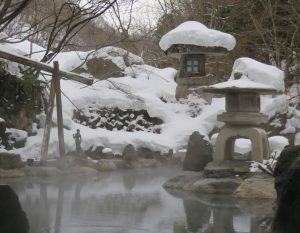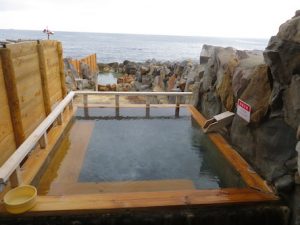Hot springs (onsen)
This is a tiny selection of the thousands of onsen and rotemburo in Japan so do let us know the details of any you recommend.
The page references are for the 5th edition of Japan by Rail.
Tokyo
Around Tokyo

Kawaguchi-ko If staying on the northern side of Kawaguchi-ko (pp142-3), one of the Fuji Five Lakes, you can sit in a rotemburo and see the reflection of Mt Fuji in the lake, as well of course as seeing Mt Fuji itself. Hotels worth considering are Koraku Onyado Fujiginkei, Kozantei Ubuya and Kukuna.
Honshu
Central Honshu
Hakone
Hakone-Yumoto (see p169) is the entry station to the Hakone region and two hotels near the station offer both onsen and rotemburo: Hakone Suimeisou and Yumoto Fujiya Hotel. Miyanoshita is the closest station to the atmospheric Fujiya Hotel, which opened in 1878. Each room has natural hot spring water and the hotel is a Registered Cultural Asset of Japan. Facilities include swimming pools and of course hot spring baths.
Minakami

To reach Minakami take the JR Joetsu line (60 mins) from Takasaki. A courtesy bus to Takaragawa-onsen Osenkaku (p180) operates once a day from Minakami station, though reservations are required. The onsen has five rotemburo (open-air baths), both mixed and single sex, and a magnificent setting.
Bessho-onsen
Bessho-onsen (pp182-3) is just under half an hour from Ueda station by local train along the Ueda Dentetsu Bessho line (JR passes not accepted). The baths at Bessho are said to have healing properties which make the skin smooth. There are several bath houses in town; two with a rotemburo (outside bath) are O-yu and Aisome-no-yu. Ryokan Hanaya is highly recommended.
Gero-onsen
Gero-onsen (p194) is one of the best-known spa towns in Japan and it dates back over 1000 years. Sumeikan is a vast onsen hotel that has a range of baths and a mass of other features. It is also only a short walk from Gero station (on the Nagoya to Takayama line), though the hotel provides a transfer service for all limited express services.
Yudanaka
Yudanaka (p213) is 50/60 minutes from Nagano by local/express train – it is worth spending the extra money on the express service: sit at the front for spectacular views from the panoramic windows. It is an onsen town and a good base for a day trip to Jigokudani (see below). Yorozuya Annex Yurukuan offers spacious Japanese- and Western-style rooms, all of them en suite, though it costs extra for a view. There are public baths as well as a rotemburo and a Jacuzzi (men can use the former in the morning and the latter in the evening; women at other times).
Kansai
Nachi
Limited expresses don’t stop here, so take a local train from Shingu. Though very small, Nachi station does have its own hot spring (onsen) called Nishiki-no-Yu; from the bath there are great views out over Nachi Bay and also of the train tracks below, so rail enthusiasts can enjoy the unusual experience of trainspotting from the comfort of a bathtub. See p241 for more information.
Kii-Katsuura
Katsuura (p242) has a number of onsen, the best known of which is Boki-do spa, inside a cave, from where there are views out to sea. The cave is part of Hotel Urashima and this provides a very different onsen experience so is well worth considering.
Shirahama

Shirahama (pp244-5) is an onsen town and a very popular summmer vacation place so it is best visited out of the main season. A highlight here is the rotemburo at Saki-no-yu as the baths face the Pacific Ocean. Other than lockers for your clothes and belongings there are no facilities so take your own towel.
Western Honshu
Kobe
A trip on a cable car (funicular) and ropeway (cable car) into the mountains can be combined with a visit to Arima-onsen (pp295-6), one of the ‘three most famous springs’ in Japan. The water quality is meant to be excellent and it has a long history of being visited by the Imperial Family and other members of the elite but the modern hotels that cater to tourists have rather spoiled the atmosphere.
Miyajima
Iwaso, in Momijidani-koen, has an onsen. The rooms are in a variety of buildings and not all are en suite. (See p311)
Tohoku
Kinugawa-onsen
Kinugawa-onsen (p326) is on the Tobu-Nikko line and can easily be reached from Nikko. There are of course many onsen hotels there but Kinugawa-Onsen Hotel is recommended.
Shiobara-onsen
Shiobara-onsen (pp326-7) can be reached by JR bus from Nasu-Shiobara. There are several onsen hotels here and many have baths facing the river that runs through the town.
Atsumi-onsen
More than 1000 years ago, Atsumi (pp349-51) served as a border checkpoint for travellers entering Tohoku. Sandwiched between mountains and the coast, Atsumi is nowadays a busy hot spring resort. The hot spring water flows from the river into the sea. The main onsen area is by the sea, a bus ride from the station. There are a few foot baths in town as well as real baths.
Aomori
If staying in Aomori (p360) and feeling the needs for an onsen consider Machinaka-onsen; it has several baths, including a Jacuzzi-style one and a rotemburo (outdoor bath), as well as a sauna. The ergonomic lilo is a very comfortable way to relax when you are thoroughly clean.
Hokkaido
Noboribetsu
Noboribetsu comes from the Ainu word ‘Nupurupetsu’, meaning ‘a cloudy river tinged with white’. A bus ride away from the station is Noboribetsu-onsen (pp370-2); it is a hot spring that draws water from Jigokudani (Hell Valley), the centre of which is a volcanic crater where steam rises from the earth. It was only in 1858, when a businessman who was mining sulphur realised there was money to be made from tourism, that the first public bath house was opened using hot water from the crater. Since then tourism has taken off and the resort is now full of concrete hotel blocks and tourist attractions.
Fukiage-onsen
Kami-Furano Bus goes as far as Tokachi-dake-onsen (the stop is called Ryo-unkaku), but get off earlier at Fukiage-onsen for a completely natural (wild) hot spring where bathing is mixed and there are no admission fees. It’s just there in the open for anybody to take a dip.
If mixed bathing in the wild is not your thing, just down the road is Fukiage-onsen Recreation Centre Hakuginso, with a variety of segregated baths at different temperatures as well as a sauna and rotemburo affording views over the mountains. Buy a ticket from the vending machine in the entrance lobby. See p386.
Sapporo
If you want to soak weary limbs after a day spent traipsing around the city, Sky Resort Spa Pulau Bulan boasts modern and minimalist single-sex hot-spring facilities on the 22nd floor of JR Tower Hotel Nikko Sapporo. It has a variety of pools, Jacuzzis, and a Finnish sauna, but best of all is the Karuna air massage bath. Massage and spa-treatment packages are also available; expect to be in the same room as other customers. See p396.
Asahidake
Hotel Bearmonte has a variety of indoor baths and rotemburo; rates depend in part on which way your room faces as some views are better than others. See pp419-21.
Kyushu
Beppu
Beppu (pp419-21) produces more hot spring water than any other onsen town so not surprisingly there are lots of onsen options here. However, another attraction is the eight ‘burning hells’ where the water is too hot for humans. Each hell has its own special feature and you can buy a ticket to visit them all.
Yufuin
If you were to make one expensive splurge on a ryokan during your trip to Japan, try Hotel Kamenoi Besso near the edge of Kinrinko. It’s an idyllic and luxurious retreat; each room boasts a private natural onsen. However, there are many other more affordable options here. (See pp422-3)
Ibusuki
The hot spring here dates back 3000 years and according to legend was discovered when a white heron put its injured leg into hot water flowing out of a crevice in some rocks. The main wooden bath house was built in 1894 and is said to be the inspiration for the bathhouse of the Gods in Miyazaki’s animated classic Spirited Away. The hot spring is now deemed one of the three most famous in Japan. However, most of the original bath house is closed for renovation till 2026 but a new one has been built in the area and there are of course several places to stay nearby which have their own onsen.
A sand-bath in naturally hot sand at Sunamushi Kaikan ‘Saraku’ is a truly wonderful experience. It is meant to improve circulation and relieve conditions such as arthritis, asthma, rheumatism, ‘alimentary disorder’ and ‘sensitivity to cold’ but should be avoided if you’re pregnant or have high blood pressure.
Having undressed and put on your yukata, follow the signs to the sand bath on the beach. You will be allocated a space and staff will cover you with the hot black sand. You are recommended to stay for only 10 minutes. (See p459)
Shikoku
Dogo-onsen
The hot spring here dates back 3000 years and according to legend was discovered when a white heron put its injured leg into hot water flowing out of a crevice in some rocks. The main wooden bath house was built in 1894 and is said to be the inspiration for the bathhouse of the Gods in Miyazaki’s animated classic Spirited Away. The hot spring is now deemed one of the three most famous in Japan. However, most of the original bath house is closed for renovation till 2026 but a new one has been built in the area and there are of course several places to stay nearby which have their own onsen. (See pp492-3)
